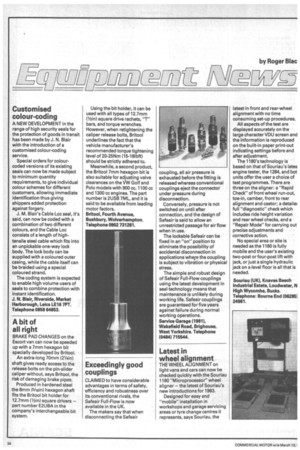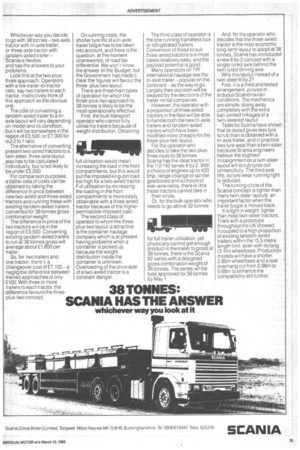Customised colour-coding
Page 36

Page 37

If you've noticed an error in this article please click here to report it so we can fix it.
A NEW DEVELOPMENT in the range of high security seals for the protection of goods in transit has been made by J. N. Blair with the introduction of a customised colour-coding service.
Special orders for colourcoded versions of its existing seals can now be made subject to minimum quantity requirements, to give individual colour schemes for different customers, allowing immediate identification thus giving shippers added protection against forgery.
J. M. Blair's Cable Loc seal, it's said, can now be coded with a combination of two different colours, and the Cable Lac consists of a length of hightensile steel cable which fits into an unpickable one-way lock body. The lock body can be supplied with a coloured outer casing, while the cable itself can be braided using a special coloured strand.
The coding system is expected to enable high volume users of seals to combine protection with instant identification.
J. N. Blair, Riverside, Market Harborough, Leics LE16 7PT. Telephone 0858 54853.
A bit of all right
BRAKE PAD CHANGES on the Escort van can now be speeded up with a 7mm hexagon bit specially developed by Britool.
An extra-long 70mm (21/4in) shaft gives ready access to the release bolts on the pin-slider caliper without, says Britool, the risk of damaging brake pipes.
Produced in hardened steel the 8mm (5/i5in) hexagon shaft fits the Britool bit holder for 12.7mm (1/2in) square drivers — part number E2URA in the company's interchangeable bit system.
Using the bit holder, it can be used with all types of 12.7mm (1/21n) square drive rachets, "T" bars, and torque wrenches. However, when retightening the caliper release bolts, Britool underlines the fact that the vehicle manufacturer's recommended torque tightening level of 20-25Nm (15-18lbft) should be strictly adhered to.
Meanwhile, a second product, the Britool 7mm hexagon bit is also suitable for adjusting valve clearances on the VW Golf and Polo models with 900 cc, 1100 cc and 1300 cc engines. The part number is 2USB 7ML, and it is said to be available from leading motor factors.
Britool, Fourth Avenue, Bushbury, Wolverhampton. Telephone 0902 731281.
Exceedingly good couplings
CLAIMED to have considerable advantages in terms of safety, efficiency and robustness over its conventional rivals, the Safeair Full-Flow is now available in the UK.
The makers say that when disconnecting the Safeair coupling, all air pressure is exhausted before the fitting is released whereas conventional couplings eject the connector under pressure during disconnection.
Conversely, pressure is not switched on until after connection, and the design of Safeair is said to allow an unrestricted passage for air flow when in use.
The lockable Safeair can be fixed in an "on" position to eliminate the possibility of accidental disconnection in applications wheire the coupling is subject to vibration or physical stress.
The simple and robust design of Safeair Full-Flow couplings using the latest development in seal technology means that maintenance is unlikely during working life. Safeair couplings are guaranteed for five years against failure during normal working operations.
Service Garage (1981), Wakefield Road, Brighouse, West Yorkshire. Telephone (0484) 715544.
Latest in wheel alignment
THE WHEEL ALIGNMENT on light vans and cars can now be checked quickly with the Souriau 1180 "Microprocessor" wheel aligner — the latest of Souriau's new introductions for 1983.
Designed for easy and "mobile" installation in workshops and garage servicing areas or tyre change centres it represents, says Souriau, the latest in front and rear-wheel alignment with no time consuming set-up procedures.
All aspects of the test are displayed accurately on the large character VDU screen and the information is reproduced on the built-in paper print-out indicating settings before and after adjustment.
The 1180's technology is based on that of Souriau's lates engine tester, the 1284, and bot units offer the user a choice of test programmes. There are three on the aligner: a "Rapid Check" of front wheel run-out, toe-in, camber, front to rear alignment and castor; a detaile( full "diagnostic" check which includes ride height variation and rear wheel checks, and a "Repair Mode" for carrying out precise adjustments and corrective action.
No special area or site is needed as the 1180 is fully mobile and the user's existing two-post or four-post lift with jack, or just a single hydraulic jack on a level floor is all that is needed.
Whichever way you decide to go with 38 tonnes— two-axle tractor with tri-axle trailer, or three-axle tractor with tandem-axled trailer — Scania.is flexible and has the answers to your problems.
Look first at the two-plusthree approach. Operators with a low trailer-to-tractor ratio, say two trailers to each tractor, instinctively think of this approach as the obvious one.
The cost of converting a tandem-axled trailer to a triaxle layout will vary depending on model and its condition, but it will be somewhere in the region of £3,500, or £7,000 for our 2 to 1 ratio.
The alternative of converting present two-axled tractors to a twin-steer, three-axle layout also has to be calculated individually, but is not likely to be under £5,000.
For comparison purposes, a better idea of costs can be' obtained by taking the difference in price between new two-axled and three-axled tractors and running these with existing tandem-axled trailers converted for 38 tonnes gross combination weight. The difference in price of the two tractors will be in the region of £3,500. Converting existing tandem-axled trailers to run at 38 tonnes gross will average about £1,800 per trailer.
So, for two trailers and one tractor, there's a changeover cost of £7,100— a negligible difference between the two approaches of only £100. With three or more trailers to each tractor, the difference favours the threeplus-two concept. On running costs, the shorter tyre life of a tri-axle trailer bogie has to be taken into account, and there is the question, at the moment , unanswered, of road tax differential. We won't know the answer till the Budget, but the Government has made it clear the figures will favour the threeplus-two layout. There are three main types of operation for which the three-plus-two approach to 38 tonnes is likely to be the most operationally effective. First, the bulk transport operator who cannot fully utilise his trailers because of weight distribution. Obtaining full utilisation would mean increasing the load in the front compartments, but this would put the imposed king-pin load too high for a two-axled tractor. Full utilisation by increasing the loading in the front compartments is more easily obtainable with a three-axlecl tractor because of the higher permissible imposed load.
The second class of operator to whom the threeplus-two layout is attractive is the container haulage company which is at present having problems when a container is picked up because the weight distribution inside the container is unknown. Overloading of the drive axle of a two-ax led tractor is a constant danger. The third class of operatOr is the one running frameless box or refrigerated trailers. Conversion of these to suit three-axled tractorsis in most cases relatively easy, and the payload potential is good. Many operators on TIR international haulage see the tri-axle trailer — popular on the continent— as the way to go. Largely their decision will be swayed by the decisions of the trailer rental companies. However, the operator with a proportion of three-axled tractors in the fleet will be able to handle both the new tri-axle trailers and tandem-axled trailers which have been modified more cheaply for the three-plus-two layout. For the operator who decides to take the two-plusthree route to 38 tonnes, Scania has the ideal tractor in the 112/142 series 4 by 2. With a choice of engines up to 420 bhp, range-change or splitter gearboxes and a choice of rear-axle ratios, there is little these tractors cannot take in their stride.
Or, for the bulk operator who needs to go above 32 tonnes for full trailer utilisation, yet physically cannot get enough product in the trailer to gross at 38 tonnes, there is the Scania 82 series with a designed gross combination weight of 36 tonnes. The series will be type approved for 36 tonnes by May 1 And, for the operator who decides that the three-axled tractor is the most economic long-term layout to adopt at 38 tonnes, Scania has introduced a new 6 by 2 concept with a single-tyred axle behind the twin-tyred driving axle. Why this layout instead of a twin-steer 6 by 2?
First, it is a tried and tested arrangement, proved in arduous Scandinavian conditions. The mechanics are simple, doing away completely with the extra ball-jointed linkages of .a twin-steered layout. Tests by Scania have shown that its layout gives less tyre scrub than is obtained with a tri-axle trailer, and in practice less tyre wear than a twin-steer because Scania engineers believe the slightest misalignment on a twin-steer layout will scrub tyres out unmercifully. The third axle lifts, so tyre wear running light is reduced.
The turning circle of the Scania concept is tighter than many twin-steer layouts, an important factor when the trailer bogie is moved back. It is light in weight, lighter than most twin-steer tractors. Trials with a prototype throughout the UK showed it coupled to a high proportion of existing tandem-axled trailers within the 15.5 metre length limit, even with its long (3.1m) wheelbase. Production models will have a shorter, 2.85m wheelbase and a rear overhang cut from 0.98m to 0.68m to enhance the compatibility still further.




























































































